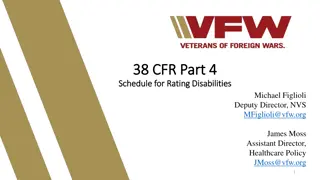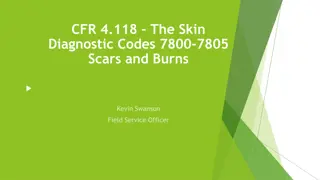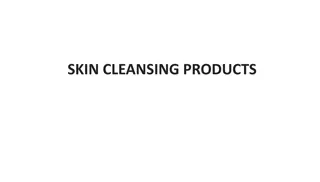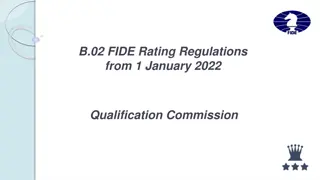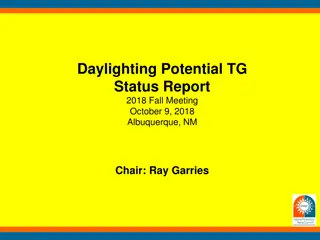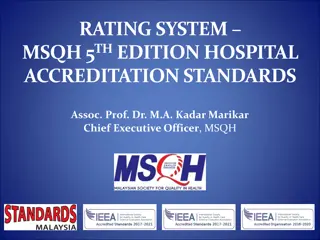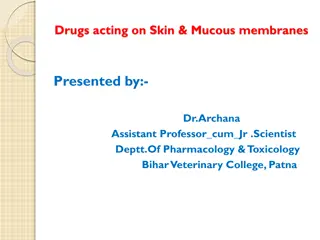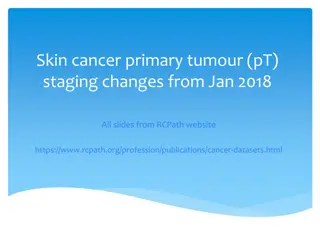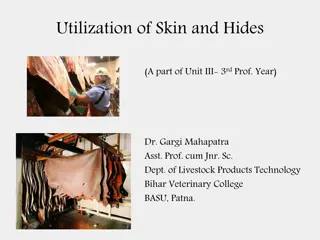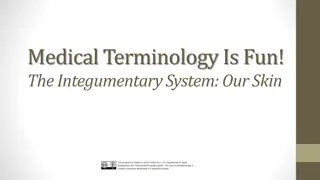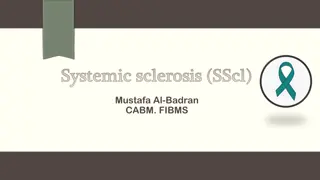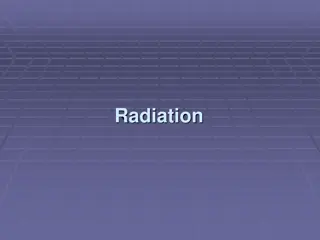Understanding Changes in Skin Rating Criteria under 38 CFR 4.118
Explore updates to the skin rating schedule under 38 CFR 4.118 by reviewing historical and new criteria, court cases like Johnson v. McDonald, and the impact of systemic therapy on disability ratings. Learn how topical treatments differentiate from systemic therapy and its effect on evaluations.
Download Presentation

Please find below an Image/Link to download the presentation.
The content on the website is provided AS IS for your information and personal use only. It may not be sold, licensed, or shared on other websites without obtaining consent from the author. Download presentation by click this link. If you encounter any issues during the download, it is possible that the publisher has removed the file from their server.
E N D
Presentation Transcript
Rating Changes 38 CFR 4.118 Skin By Diane Williams November 2019
Objectives Review updates and changes to the rating schedule for skin. Determine correct evaluations and effective dates, considering historical and new criteria. Evaluate skin conditions with accuracy in scenarios provided. Review skin conditions and treatments 2
References 38 CFR 3.309 (e) Diseases associated with herbicide agents. 38 CFR 3.344 Stabilization of disability evaluations 38 CFR 3.400 Effective Dates, General 38 CFR 3.951(a) Preservation of disability ratings 38 CFR 4.9 Congenital or developmental defects 38 CFR 4.118 Schedule of ratings skin 3
References (cont.) M21-1 Part III, Subpart iv, 4.L Skin conditions M21-1 Part III, Subpart iv, 5.C Effective Dates Johnson v. McDonald McClain v. Nicholson 4
Reason for change-court cases Johnson v. McDonald clarified the definition of systemic therapy such as corticosteroids or other immunosuppressive drugs, contained in certain DCs under 38 CFR 4.118: 5
Review of court cases Johnson stated: Systemic therapy refers to any oral or parenteral medication(s) prescribed by a medical professional to treat the underlying skin disorder. Medications that are applied topically (directly to the skin), including topical corticosteroids or immunosuppressives, are not considered systemic for VA purposes. Impact? 6
Review of court cases Johnson created a dramatic disconnect between the severity of the veteran s disability and the corresponding rating. Therefore, VA amended 4.118 to clearly provide that VA does not intend for treatment administered through the skin (topical therapy) to constitute systemic therapy. VA notes that it is possible for topical treatments to have systemic effects if administered on a large enough scale. However, in these situations, a veteran can obtain a higher rating due to the percentage of the body affected, not the mode of administration for his or her treatment. 7
Old criteria for illustration 7806 Dermatitis or eczema. 60 More than 40 % of the entire body or of exposed areas affected, or: constant or near-constant systemic therapy such as corticosteroids or other immunosuppressive drugs required during the past 12-months 30 20 to 40 % of the entire body or of exposed areas affected, or; systemic therapy such as corticosteroids or other immunosuppressive drugs required for a total duration of 6 weeks or more, but not constantly during the past 12 months 10 At least 5 %, but <20 %, of the entire body, or exposed areas affected, or; intermittent systemic therapy such as corticosteroids or other immunosuppressive drugs required for a total duration of less than six weeks during the past 12-months. 0 Less than 5 % of the entire body, or of exposed areas affected, and; no more than topical therapy required during the past 12-months. 8
Review of Court Cases McClain v. Nicholson, found that: the requirement a currentdisability is satisfied when the claimant has the disability at the time the claim for VA disability compensation is filed or during the pendency of the claim and that a claimant may be granted service connection even though the disability resolves prior to VA s adjudication of the claim. 9
Review of Court Case Impact? Conditions should be examined or evaluated when the condition is active. 10
Reasons for change Other considerations: Several of the skin disorders have similar superficial components of the skin, and the severity of impairment for each condition increases as more skin is involved. All of the conditions have treatments which are applied directly to the skin, as well as taken systemically (e.g., by mouth). There are still more similarities with regard to which treatments are used, treatment dosages given, treatment routes of administration, and treatment duration. As a result, VA concluded it would be more efficient to rate under the same formula, rather than to prescribe individual rating criteria. 11
CFR 4.118 changes (New in red) Introductory text revision two notes a) For the purposes of this section, systemic therapy is treatment that is administered through any route (orally, injection, suppository, intranasally) other than skin. For the purposes of this section, topical therapy is treatment administered through the skin. 12
4.118 continued b) Two or more skin conditions may be combined in accordance with 38 CFR 4.25 only if separate areas of skin are involved. If two or more skin conditions involve the same area of skin, then only the highest evaluation shall be used. 13
New! General Rating Formula The new rating formula accounts for percentages of areas affected, both of the entire body and exposed areas, as well as the level of treatment required. 14
New! General Rating Formula General Rating Formula For The Skin For DCs 7806, 7809, 7813-7816, 7820-7822, and 7824: At least one of the following Characteristic lesions involving more than 40 percent of the entire body or more than 40 percent of exposed areas affected; or 60 Constant or near-constant systemic therapy including, but not limited to, corticosteroids, phototherapy, retinoids, biologics, photochemotherapy, psoralen with long-wave ultraviolet-A light (PUVA), or other immunosuppressive drugs required over the past 12-month period 60 15
New! General Rating Formula General Rating Formula For The Skin For DCs 7806, 7809, 7813-7816, 7820-7822, and 7824: At least one of the following Characteristic lesions involving 20 to 40 percent of the entire body or 20 to 40 percent of exposed areas affected; or Systemic therapy including, but not limited to, corticosteroids, phototherapy, retinoids, biologics, photochemotherapy, PUVA, or other immunosuppressive drugs required for a total duration of 6 weeks or more, but not constantly, over the past 12-month period 30 16
New! General Rating Formula General Rating Formula For The Skin For DCs 7806, 7809, 7813-7816, 7820-7822, and 7824: At least one of the following 10 Characteristic lesions involving at least 5 percent, but less than 20 percent, of the entire body affected; or At least 5 percent, but less than 20 percent, of exposed areas affected; or Intermittent systemic therapy including, but not limited to, corticosteroids, phototherapy, retinoids, biologics, photochemotherapy, PUVA, or other immunosuppressive drugs required for a total duration of less than 6 weeks over the past 12- month period 17
New! General Rating Formula General Rating Formula For The Skin For DCs 7806, 7809, 7813-7816, 7820-7822, and 7824: No more than topical therapy required over the past 12- month period and at least one of the following Characteristic lesions involving less than 5 percent of the entire body affected; or Characteristic lesions involving less than 5 percent of exposed areas affected Or rate as disfigurement of the head, face, or neck (DC 7800) or scars (DCs 7801, 7802, 7804, or 7805), depending upon the predominant disability. This rating instruction does not apply to DC 7824 0 18
New! General Rating Formula The following DC are evaluated under the new General Rating Formula: 7806 Dermatitis or Eczema 7809 Discoid lupus erythematosus 7813 Dermatophytosis 7815 Bullous disorders 7816 Psoriasis 19
New! General Rating Formula 7820 Infections of the skin not listed elsewhere 7821 Cutaneous manifestations of collagen-vascular diseases not listed elsewhere 7822 Papulosquamous disorders not listed elsewhere 7824 Diseases of keratinization 20
SCARS - DC 7801 & 7802 DC 7801 & 7802 Burn Scars, Scars due to Other Causes, DC 7801 of the Head, face or neck DC 7802 other than the Head, face or neck Removed deep and linear and superficial and non-linear Replaced with that are associated with underlying soft tissue damage. 21
DC 7801 & 7802 notes Note 1 and 2 changed - Note 1 defines the six zones of the body each extremity, anterior trunk, and posterior trunk. Use midaxillary line to divide the anterior trunk from posterior trunk. 22
DC 7801 & 7802 notes -Note 2: A separate evaluation may be assigned for each affected zone of the body under this DC if there are multiple scars, or a single scar, affecting multiple zones of the body. Combine separate evaluations under CFR 4.25. Alternatively, if a higher evaluation results from adding areas from multiple zones of the body, a single evaluation may be assigned under the diagnostic code. 23
DC 7802- 7805 (Scar DCs) DC 7802 - Scars superficial and nonlinear, other than the head face or neck. DC 7804 - Scars, unstable or painful. DC 7805, Scars, other; and other effects of scars evaluated under DC 7800, 7801, 7802 or 7804 The phrase including linear scars was removed from the DC 7805 description 24
DC descriptions (changes in red) 7809 Discoid lupus erythematosus (DLE) (subacute cutaneous lupus erythematosus is removed) 7813 Dermatophytosis (ringworm, tinea corporis, tinea pedis, tinea barbae, tinea unguium, tinea cruris, and tinea versicolor (added) 25
DC descriptions (changes in red) 7821 Cutaneous manifestations of collagen- vascular disease not listed elsewhere (including scleroderma, calcinosis cutis, subacute cutaneous lupus erythematosus, and dermatomyositis) 7822 Papulosquamous disorders not listed elsewhere (including lichen planus, large or small plaque parapsoriasis, pityriasis lichenoides et varioliformis acuta (PLEVA), lymphomatoid papulosus, mycosis fungoides and pityriasis rubra pilaris (PRP) 28
DC notes (changes in red) 7815 Bullous disorders Added Note: Rate complications and residuals of mucosal involvement (ocular oral, gastrointestinal, respiratory, or genitourinary) separately under the appropriate DC. 7816 Psoriasis: Added Note: Rate complications such as psoriatic arthritis and other clinical manifestations (oral mucosa, nails) separately under the appropriate DC 30
Psoriasis Psoriasis Psoriatic Arthritis 32
DC 7825 Chronic urticaria (hives) Evaluations based on chronicity and line of treatment 7825 Chronic urticaria: For the purposes of this diagnostic code, chronic urticaria is defined as continuous urticaria at least twice per week, off treatment, for a period of six weeks or more Chronic refractory urticaria that requires third line treatment for control (e.g., plasmapheresis, immunotherapy, immunosuppressives) due to ineffectiveness with first and second line treatments 60 Chronic urticaria that requires second line treatment (e.g., corticosteroids, sympathomimetics, leukotriene inhibitors, neutrophil inhibitors, thyroid hormone) for control 30 Chronic urticaria that requires first line treatment (antihistamines) for control 10 33
DC 7826 Vasculitis DC 7826 Vasculitis Changed debilitating episodes to documented vasculitic episode. 35
DC 7827 changes DC 7827 Erythema multiforme; Toxic epidermal necrolysis. Changes debilitating episodes to recurrent mucosal, palmar, or plantar involvement Defines systemic therapy (for this DC only) as immunosuppressives, antihistamines, or sympathomimetics 36
DC 7828 & 7829 changes DC 7828 Acne. Removed superficial cysts DC 7829 Chloracne Removed superficial cysts Adds 20 percent evaluation level: 7829 Chloracne 20 Deep acne (deep inflamed nodules and pus-filled cysts) affecting the intertriginous areas (the axilla of the arm, the anogenital region, skin folds of the breasts, or between digits) 38
Other changes DC 7817 Erythroderma (changed from Exfoliative dermatitis (erythroderma) Added biologics to systemic therapy examples Allows for evaluation in cases of documented history of treatment failure Defines treatment failure: Either disease progression, or less than a 25 percent reduction in the extent and severity of disease after four weeks of prescribed therapy, as documented by medical records. 39
General Considerations-Scars: Exposed areas as referenced in evaluation criteria refer to the face, neck, and hands. (M21-1.III.iv.4.L.1.g.) An unstable scar is a scar in which, for any reason, there is frequent loss of covering of skin over the scar. (DC 7804) Painful scar is found when there is objective indication supporting subjective reports of pain or tenderness. (M21-1.III.iv.4.L.3.b) 40
General Considerations-Scars: Scar measurements: The DBQ requires measurements of Linear, Superficial non-linear, and Deep non-linear scars. The length and width of each scar is measured in centimeters. Approximate total area by extremity, or trunk area, is provided on the DBQ. 41
Common skin conditions Most common skin conditions include: Scars Acne Pseudofolliculitis Barbae Eczema Dermatitis Tinea infections Psoriasis 42
Eczema 43
Non-Disabilities The following are not disabilities for VA purposes: Androgenetic alopecia Birthmarks, moles Scars from elective procedures 44
Which criteria apply? Does the veteran warrant a higher evaluation under the old criteria? Do they qualify for an increase under the new criteria? Is there an intent to file (ITF) to consider? What date did the claim come in? Is the date entitlement arose based on an increase shown in medical records the applicable effective date? When was the Veteran released from active duty? Should the effective date be RAD+1? 47
Scars and Skin Conditions DBQs Does the DBQ or exam of record give information needed for current criteria? Did you check for issues considered within the scope of the claim of inferred issues that were brought to issue on the DBQ? Were all relevant sections pertaining to the condition completed? 48
Remember the skin law change, effective August 13, 2018 Not Liberalizing Legislation under 38 CFR 3.114 49
QUESTIONS? Diane Williams


